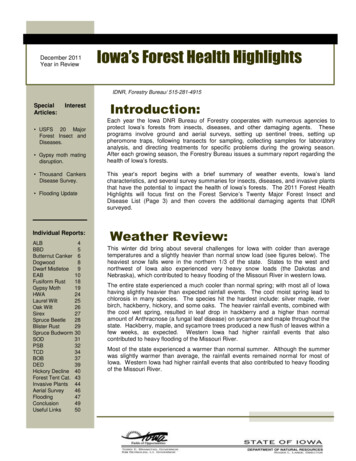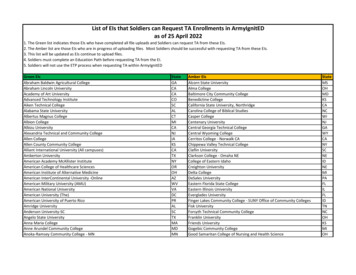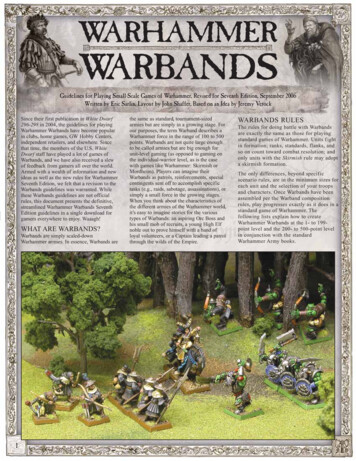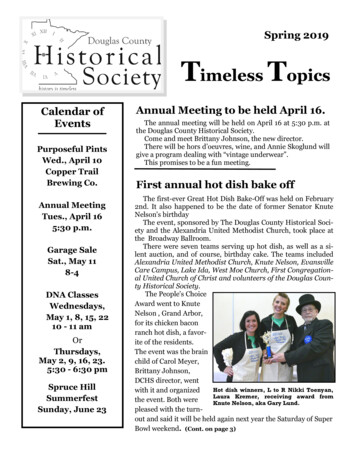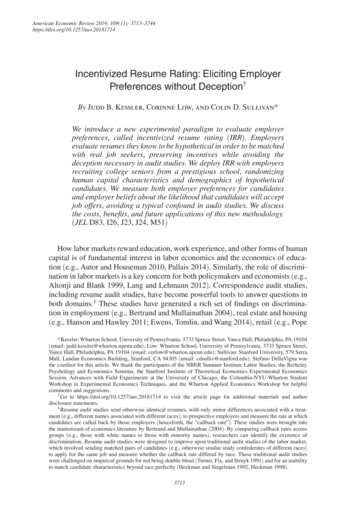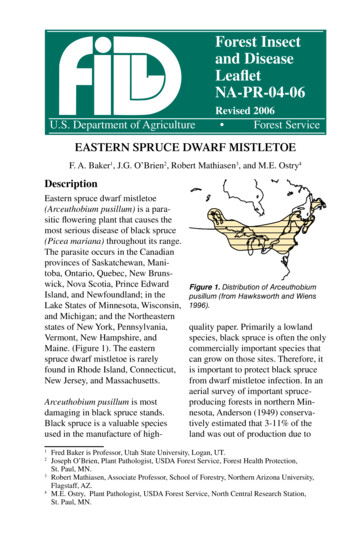
Transcription
Forest Insectand DiseaseLeafletNA-PR-04-06Revised 2006U.S. Department of Agriculture Forest ServiceEASTERN SPRUCE DWARF MISTLETOEF. A. Baker , J.G. O’Brien , Robert Mathiasen , and M.E. Ostry DescriptionEastern spruce dwarf mistletoe(Arceuthobium pusillum) is a para sitic flowering plant that causes themost serious disease of black spruce(Picea mariana) throughout its range.The parasite occurs in the Canadianprovinces of Saskatchewan, Mani toba, Ontario, Quebec, New Bruns wick, Nova Scotia, Prince EdwardIsland, and Newfoundland; in theLake States of Minnesota, Wisconsin,and Michigan; and the Northeasternstates of New York, Pennsylvania,Vermont, New Hampshire, andMaine. (Figure ). The easternspruce dwarf mistletoe is rarelyfound in Rhode Island, Connecticut,New Jersey, and Massachusetts.Arceuthobium pusillum is mostdamaging in black spruce stands.Black spruce is a valuable speciesused in the manufacture of high Figure 1. Distribution of Arceuthobiumpusillum (from Hawksworth and Wiens1996).quality paper. Primarily a lowlandspecies, black spruce is often the onlycommercially important species thatcan grow on those sites. Therefore, itis important to protect black sprucefrom dwarf mistletoe infection. In anaerial survey of important spruceproducing forests in northern Min nesota, Anderson ( 9 9) conserva tively estimated that - % of theland was out of production due toFred Baker is Professor, Utah State University, Logan, UT.Joseph O’Brien, Plant Pathologist, USDA Forest Service, Forest Health Protection,St. Paul, MN.Robert Mathiasen, Associate Professor, School of Forestry, Northern Arizona University,Flagstaff, AZ.M.E. Ostry, Plant Pathologist, USDA Forest Service, North Central Research Station,St. Paul, MN.
eastern spruce dwarf mistletoe.Although white spruce (Piceaglauca) and red spruce (Picearubens) are also highly susceptible tothis parasite, eastern dwarf mistletoeis not as common on these trees,perhaps because they rarely occur inpure stands. In the United Stateswhite spruce is frequently infectedalong the coast of Maine and on thenorth shore of Lake Michigan. Redspruce is commonly infected in oldgrowth forests in New York, Vermont,New Hampshire, and Maine. Otherhosts include eastern larch (Larixlaricina), jack pine (Pinus banksi ana), eastern white pine (Pinusstrobus), red pine (Pinus resinosa),balsam fir (Abies balsamea), and blue Figure 2. Flowers on staminate (male;top) and pistillate (female; bottom)spruce (Picea pungens), but thesehosts are infected only when growingnear other infected species of spruce.Life HistoryDwarf mistletoes are small, seedbearing, parasitic plants. Easterndwarf mistletoe has green to brownexternal (aerial) shoots, usually nosecondary branching, and leavesreduced in size to small scales. Theshoots are perennial, usually about0. - .0 inches ( - .5 cm) long. Themajor function of aerial shoots is re production. Male and female flowersare small and produced on separateplants (Figure ). Flowering takesplace from late March until earlyJune, peaking in April and May. In sects and wind are involved in polli nation of female flowers. Male aerialshoots are shed soon after flowering,female shoots are shed after they dis perse their seeds. Basal cups remainFigure 3. Basal cups remaining afteraerial shoots are shed.on the portions of branches whereaerial shoots had formed (Figure ).Dwarf mistletoe plants containchlorophyll so they produce somephotosynthate, but they obtain mostof their nutrients from the livingtissues of the host through what iscalled the endophytic system. Thisroot-like network consists of corti cal strands growing within the barkand sinkers within the wood. The
away than by natural discharge,potentially starting new infectioncenters. Viscin, when first moistenedby rains, acts as a lubricant. Seedsslide down and either fall off needlesor become lodged on bark at the baseof needles (Figure 5). Seeds are fas tened in place when the viscin driesand they overwinter in a dormantstate. Many seeds are destroyed byinsects and fungi or dislodged by rainand snow, so only a small propor tion of the those dispersed actuallysurvive and give rise to new plants.Figure 4. Mature fruits (berries) on apistillate plant.endophytic system lives as long asadjacent host tissues are alive.Fruits mature in August or Septemberof the same year they were polli nated. Each mature fruit contains oneseed about 0. inch ( mm) in length(Figure ). Seeds are dischargedexplosively from ripe fruits in Augustand September. They may travelas far as 55 feet ( 6.5 m), but mostland within 0- 5 feet ( -5 m) of thedisseminating shoot. A sticky seedcoating called viscin enables seeds tostick to objects they strike. Foliage isthe most common receiving surface.Seeds also can stick to the bodiesof birds and squirrels as they foragein infected trees. Animals can inad vertently carry seeds to trees fartherFigure 6. Germinating seed of Arceuthobium pusillum with its characteristic redradicle (arrow).Seeds germinate in the spring. Astructure called a radicle emergesfrom a germinating seed and growsalong the bark surface, and penetratesthe host tissue (Figure 6). Themistletoe’s endophytic system thendevelops in the bark and wood of thehost. Infection occurs most readilyin - to 5-year- old twigs becausetheir bark is more easily penetratedthan older twigs. For two or moreyears, these infections are quiescent,or latent, and there are no symptoms.The first symptom is a swelling at thepoint of infection. Buds proliferateFigure 5. Dwarf mistletoe seed attachedto black spruce needles with viscinthreads.
effect (Figure 7). If the tree is vigor ous, the infected tissue may havelonger internodes than uninfectedtissue (Figure 8). Initial growth ofthe witches’ broom may be quitevigorous (Figure 9). Aerial shootstypically appear years after infec tion, and these produce flowers andfruits in their fifth year. Thus, plantsneed at least 5 years to completetheir life cycle from initial establish ment to dissemination of the firstseed crop. Many successive crops ofaerial shoots may be produced fromthe established endophytic system.Figure 7. Epinastic effect in infectedtissue (left image). Apical dominance isdisrupted.Symptoms and Signs ofInfectionWitches’ brooms are the most ap parent symptom of dwarf mistletoeinfection on spruce (Figure 0).They live as long as the host remainsFigure 8. Dwarf mistletoe infectedbranches have longer internodes (leftimage) than uninfected tissue in vigoroustrees.Figure 9. Developing witches’ broom.Note the orange discoloration of the barkof infected tissue.at this point, giving rise to a witches’broom, a compact mass of branchesand twigs. The apical dominance ofinfected tissue is released, and thebranches often exhibit an epinasticFigure 10. Large witches’ brooms on infected trees. Note the thin upper crownsof these declining trees.
alive and may reach - 0 feet ( - m) in diameter. Branches in thesebrooms may have several mistletoeplants on them. Uninfected tissuesdecline first, until nearly all thefoliage is contained in the witches’brooms, and the tree is near death.The upper crown often dies first,so severely infected trees usuallyhave dead tops. After a tree diesand loses its needles, basal cupson branches allow observers todistinguish mistletoe brooms fromthose associated with spruce broomrust (Chrysomyxa arctostaphyli).and white spruce. Dwarf mistletoekills these trees so quickly, oftenwithin 5 years, that there is littlebenefit to rating disease intensity.ImpactsDamage to spruce due to mistletoeinfection includes increased mortal ity, reduced growth rates and loss ofvigor, lowered timber quality, re duced cone and seed production, andincreased susceptibility to other dam aging agents. These damaging effectsresult from the dwarf mistletoe plantstaking food and water from the host,thus reducing the amount availableSpread and Intensificationfor the tree’s normal growth, defense,While many factors influence tree-to and reproduction. Dwarf mistletoe istree spread of eastern spruce dwarfthe major cause of reduced stockingmistletoe, these are not terribly im in the black spruce forest type. In se portant because the trees are killed so verely infested areas, stocking levelsquickly. The parasite spreads aboutare so low that a commercial harvest . feet per year, as measured on the is impossible. Dwarf mistletoe killsground between the boles of infected young spruce saplings, which alsotrees. The spread rate through acontributes to reduced stocking.stand, as indicated by the enlarge ment of mortality centers, is almostWeakened trees are more susceptibledouble this at .7 feet per year. While to drought and attack by insectswe might expect spread rates in very and fungi. Black spruce growingdense stands to be less than in moreon organic sites are not windfirm.open stands, the rapid mortalityWhere the stand canopy has beenof infected trees negates any suchopened by mortality caused byeffects. Nearly all spread is local and dwarf mistletoe, large lossesresults from explosive discharge ofdue to windthrow can occur.seeds. Wind exerts a minor influenceon distance and direction of seedDwarf mistletoes are a functionaltravel. Birds and other animals withcomponent of many forest eco seeds on their bodies can rub themsystems, having intrinsic value asoff onto susceptible trees, creatingindividual species and as disturbancenew mortality centers. The 6-classagents, influencing both the structuredwarf mistletoe rating (DMR) system and function of forest communities.in common use in the western U.S.In areas where wildlife and plantis not useful for quantifying inten diversity or aesthetic values are moresity of infection in stands of blackimportant, allowing a dwarf mistletoe5
infestation to continue may be ap propriate. In other areas where timberproduction or developed recreationis the primary goal, direct control ofdwarf mistletoes may be warranted.without showing symptoms), willeliminate dwarf mistletoe. Prescribedburning the slash remaining afterlogging can eliminate residual blackspruce. In addition to consumingor scorching residual trees, fire alsofavors sphagnum mosses, whichprovide an optimal seed bed for blackspruce. However, black spruce standare commonly harvested using fulltree and tree length logging systems.These logging methods rarely yieldthe aerial slash necessary to carry afire of sufficient intensity to kill re sidual trees. Harvesting equipment, ifnot restricted by deep snow, shallowfrost, or both, can kill the residuals,and eliminate dwarf mistletoe in theregenerating stand. Where residualtrees survive harvesting, additionalmeasures are required. Dispatchingcrews to cut residuals with chainsaws or brush saws has not beeneffective, perhaps because only in fected trees were cut, and “apparentlymistletoe-free” trees were infected.Sodium trichloroacetate (TCA) caneffectively kill black spruce at areasonable cost, without affecting theManagementEffective management of mistletoeinfested black spruce stands requireseradication of the parasite becauseA. pusillum kills black spruce veryquickly, creating mortality centersin a stand. The mortality centercontinues to enlarge during rotation,ultimately removing significantareas of the stand from production.In stands managed for timber, themortality caused by dwarf mistletoeis almost always unacceptable. Toprevent these losses, the mistletoeshould be eradicated from regenerat ing stands. Volume losses and areaout of production can be projectedusing DMLOSS, which has recentlybeen modified to work with a geo graphic information system (Table ). Any treatment that kills all treessurviving on the site, infected ornot (because trees may be infectedTable 1. DMLOSS projection of losses in a 15-hectare infested black spruce stand.This stand regenerated with 16 infected trees per acre. Treatment area includes a20-m buffer around the infested mewith dwarfmistletoe(m3)Standvolumelost (m3)Stand AgeInfestedarea (ha)Volumelost (%)Treatmentarea .71,4661,019447309.93.16
Referencessphagnum moss seedbed or germinat ing spruce seeds. Regardless of themethod, all residual black sprucemust be killed to ensure that theregenerating stand is free of dwarfmistletoe. Mechanical treatmentssuch as shearing or using a hydroaxemay be used to eliminate residualspruce, but cost, access, and abilityto move on the site during most ofthe year can limit their effectiveness.Anderson, R.L. 9 9. The sprucedwarf mistletoe in Minne sota., University of Minnesota,St. Paul, 9p. Masters Thesis.Baker, F.A. 98 . Biology and controlof the eastern dwarf mistletoe.PhD Thesis, University of Min nesota, Minneapolis, MN 5 p.Baker, F.A.; French, D.W. 980.Spread of Arceuthobium pusil lum and rates of infection andmortality in black spruce stands.Plant Disease. 6 : 07 - 076.Leaving even 6 infected trees peracre after harvest has allowed dwarfBaker, F.A.; French, D.W. 99 . Radialmistletoe to increase and causeenlargement of mortality centersserious losses in the regeneratedcaused by Arceuthobium pusil stand (Table ). Regardless of howlum Peck in black spruce stands.residuals on the site are eliminated,Forest Science. 7: 6 - 67.treatment block boundaries must beBaker, F.A.; French, D.W.; Hudler,established in mistletoe-free areas.G.W. 98 . Development ofHarvesting should extend at least Arceuthobium pusillum onchains ( 0 m) beyond obvious infec inoculated black spruce. For tion to ensure that all latent infectionsest Science. 7: 0 - 05.are removed. If a dwarf mistletoeBaker, F.A.; French, D.W.; Rose,free perimeter cannot be establishedD.W. 98 . DMLOSS: a simula in regenerating stands, an areator of losses in dwarf mistletoe 0- 0 m wide adjacent to the infesta infested black spruce stands.tion should be maintained free of hostForest Science. 8: 590-598.plants or regenerated with a less sus ceptible species such as eastern larch. Baker, F.A.; Knowles, K. 00 . Casestudy: 6 years of dwarf mistletoeA buffer of resistant species willin a regenerating black spruceprovide a barrier to dwarf mistletoestand. Northern Journal of Ap invasion of the regenerating stand.plied Forestry. : 50- 5 .AssistanceHawksworth, Frank G.; Wiens,D. 996. Dwarf mistletoes:biology, pathology, and system atics. USDA Forest Service,Agric. Handbk. 709 0p.Resource managers and forestlandowners can get more informa tion about the identification andmanagement of black spruce dwarfmistletoe by contacting their localstate forestry office, or their re gional USDA Forest Service, ForestHealth Protection (FHP) office.Ostry, M. E.; Nicholls, T. H. 976. Howto identify eastern dwarf mistletoeon black spruce. USDA ForestService, North Central Forest Ex periment Station, St. Paul, MN. 5 p.7
Ostry, M.E.; Nicholls, T.H.; French,D.W. 98 . Animal vectors of east ern spruce dwarf mistletoe of blackspruce. Res. Pap. NC- . St. Paul,MN: U.S. Department of Agricul ture, Forest Service, North CentralForest Experiment Station. 6p.Pesticides used improperly can be injurious to humans, animals, and plants. Follow thedirections and heed all precautions on the labels. Store pesticides in original containersunder lock and key-out of the reach of children and animals-and away from food andfeed. Apply pesticides so that they do not endanger humans, livestock, crops, beneficialinsects, fish, and wildlife. Do not apply pesticides when there is danger of drift, whenhoney bees or other pollinating insects are visiting plants, or in ways that may contaminate water orleave illegal residues. Avoid prolonged inhalation of pesticide sprays or dusts; wear protective clothingand equipment if specified on the container. If your hands become contaminated with a pesticide, donot eat or drink until you have washed. In case a pesticide is swallowed or gets in the eyes, follow thefirst-aid treatment given on the label, and get prompt medical attention. If a pesticide is spilled on yourskin or clothing, remove clothing immediately and wash skin thoroughly. Do not clean spray equip ment or dump excess spray material near ponds, streams, or wells. Because it is difficult to remove alltraces of herbicides from equipment, do not use the same equipment for insecticides or fungicides thatyou use for herbicides. Dispose of empty pesticide containers promptly. Have them buried at a sanitaryland-fill dump, or crush and bury them in a level, isolated place. NOTE: Some States have restrictionson the use of certain pesticides. Check your State and local regulations. Also, because registrations ofpesticides are under constant review by the Federal Environmental Protection Agency, consult yourcounty agricultural agent or State extension specialist to be sure the intended use is still registered.CAUTION:PESTICIDESThe U.S. Department of Agriculture (USDA) prohibits discrimination in all its programs andactivities on the basis of race, color, national origin, age, disability, and where applicable, sex,marital status, familial status, parental status, religion, sexual orientation, genetic information,political beliefs, reprisal, or because all or part of an individual’s income is derived from anypublic assistance program. (Not all prohibited bases apply to all programs.) Persons with dis abilities who require alternative means for communication of program information (Braille, largeprint, audiotape, etc.) should contact USDA’s TARGET Center at ( 0 ) 7 0- 600 (voice andTDD). To file a complaint of discrimination, write to USDA, Director, Office of Civil Rights, 00 Independence Avenue, S.W., Washington, D.C. 0 50-9 0, or call (800) 795- 7 (voice) or ( 0 ) 7 0-6 8 (TDD). USDA is an equal opportunity provider and employer.Published by:USDA Forest ServiceNortheastern AreaState and Private Forestry11 Campus Boulevard, Suite 200Newtown Square, PA 19073August 2006www.na.fs.fed.us
distinguish mistletoe brooms from those associated with spruce broom rust (Chrysomyxa arctostaphyli). Spread and Intensification While many factors inluence tree-to tree spread of eastern spruce dwarf mistletoe, these are not terribly im portant because the trees are killed so quickly. The parasite spreads about . feet per year, as measured .
